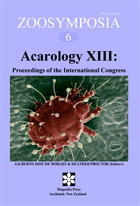Abstract
Despite the diverse and frequent use of medicinal and aromatic plants throughout the world, they have received poor attention regarding the mites and insects that they harbor. Here we summarize the diversity of phytophagous and predatory mites recorded on medicinal and aromatic plants in India, including first-hand information obtained by the authors in regular observations of plants growing in different parts of India between 2002 and 2009 as well as information reported in previous works conducted in the country. In total, 267 mite species of 93 genera and 18 families were found or have been reported on these plants in India.Most of these species (208) belong to families constituted mostly by phytophages, but quite a large number of species (56) belong to families constituted predominantly by predators. Despite the wide array of phytophagous species, relatively few have behaved as major pests, which may be at least in part due to the effect of the predatory mites with which they have been found. We consider 17 species as major pests of medicinal and aromatic plants and 11 species as main predators. The search for prospective predatory mites and the study of the feasibility of their use for the control of mite pests on medicinal and aromatic plants is worthwhile, given that a considerable proportion of people interested on the use of medicinal plants are adverse to the ingestion of synthetic pesticides residues, which could be found on those plants if the pests were controlled with the use of those products.

